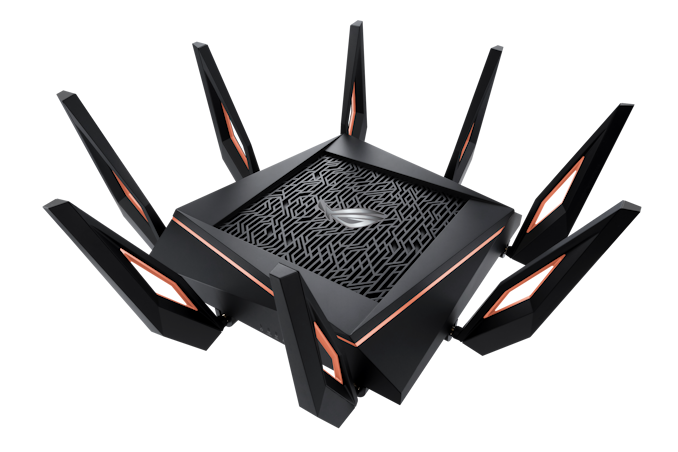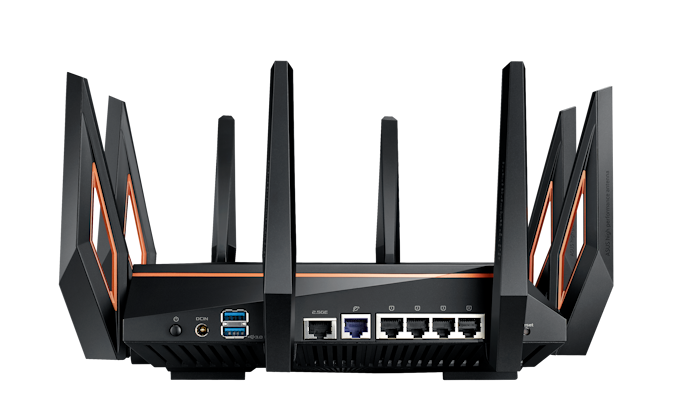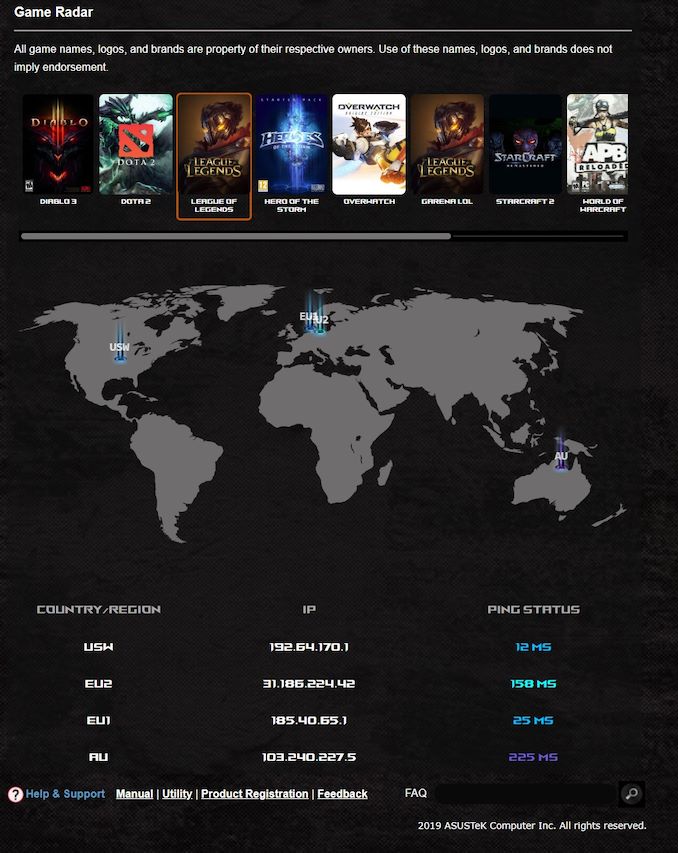AT 101: Wi-Fi 6 And Why You Want It
by Brett Howse on February 12, 2020 8:00 AM ESTThe 2020 AnandTech Wi-Fi Test Bed
We’ve been comfortably using Wi-Fi 5 for some time now, and it is only in the last several months that laptops have been shipping with Wi-Fi 6 based networking, mostly thanks to Intel’s Project Athena which has a requirement of the Intel AX200 Wi-Fi module, which is Intel's first Wi-Fi 6 based module on the market. Previously almost all shipping laptop computers offered Wi-Fi 5, and even a few with the latest Intel wireless adapters such as the Wireless-AC 9260 offered the advanced Wi-Fi 5 options such as 160 Mhz channel width, and MU-MIMO, so its nice to see a move to a new standard which includes these benefits across the board.
Although there are now quite a few Wi-Fi 6 routers and access points on the market, we had some specific criteria to meet. The router had to support Wi-Fi 6, and the 160 MHz channels, but because we are testing for performance, and not for capacity, we need an access point with a multi-Gigabit Ethernet connection. A typical laptop with a 2x2:2 network connection will be connecting to the access point at 2.4 Gbps, so transferring files from Ethernet over Gigabit will be a bottleneck. This does limit the selection somewhat.
After evaluating several models, we decided on the ASUS ROG Rapture GT-AX11000. The name is a mouthful, but meets all of our criteria and more. Most importantly, it offers the coveted 2.5 GbE port.
The ASUS ROG Rapture GT-AX11000
As the name implies, this router from ASUS can support up to 11000 Mbps over wireless, thanks to the 4x4 2.4 GHz, offering 1148 Mbps, and the two 4x4 5 GHz networks each offering 4804 Mbps. This adds up to just under 11000 Mbps, although with wireless the maximum connection speed is pretty much impossible to achieve. With the two separate 5 GHz networks, you can easily split off your consumption devices with higher priority devices, reducing interference on each network.
On the Wide Area Network (WAN) side there is a single 1 Gbps connection, and on the Local Area Network (LAN) side there are four 1 GbE and the single 2.5 GbE connection.
This router is built for capacity, with eight external antennae, and being a gaming router it also offers plenty of RGB lighting options. For those that don’t need the lighting, it can be turned off. ASUS also some tools to change the priority of gaming packets to reduce latency, assuming your network is that busy, and specifically prioritizes traffic from other ROG devices to make setup as easy as possible. ASUS even includes a utility to ping the various game servers for popular multiplayer games to provide you a map of latency to each one.
The GT-AX11000 also integrates with the ASUS AiMesh networking equipment to provide a whole-home mesh network, if even a router of this size can’t cover the entire house, either due to size or building materials blocking the signal.
For testing, the router is used in the access point mode, with the LAN connecting being over the 1 Gbps Ethernet, and a server connected directly to the router in the 2.5 Gbps port.













149 Comments
View All Comments
Makaveli - Wednesday, February 12, 2020 - link
Not quite that high.Ontario remained, by far, the most populous province in Canada with 13.4 million people calling it home in 2016, representing 38.3% of the Canadian population. This share was down slightly from the 100-year high of 38.5% in 2006.
So for american's you would consider Ontario the state.
And Ontario is a pretty big land mass 415,600 mi²
https://www150.statcan.gc.ca/n1/daily-quotidien/17...
Flunk - Wednesday, February 12, 2020 - link
Look up a population map, the vast majority of Ontario is sparsely populated, the area around Toronto & Hamilton is densely populated.andrewaggb - Wednesday, February 12, 2020 - link
In western canada your fastest options from the major providers are Telus gigabit 940/940 or Shaw Cable 600/20Neither needs more than a gigabit port. I'm sure telus could do faster but they aren't offering it.
mdrejhon - Thursday, February 13, 2020 - link
Buddy, something like ~25% of Canada lives within 2 hours drive of Toronto. There's millions of houses with access to gigabit connections.I'm in Canada and I'm on gigabit (Cogeco UltraFibe) and Bell is coming to lay fiber, so we'll have 2 gigabit ISPs competing in my city (lowly Hamilton)
Sure, if you go to the artic or the middle of our vast Canadian farmlands, it's crappy Internet. But if you go to populated Canada, there's lots of good Internet connections in urbanized Northeast Corridor now.
sonny73n - Friday, February 14, 2020 - link
“Canada is barely faster than Mexico”So they both have super fast internet compared to the where I live - the US. I only get 1.5 Mbps from the only ISP available in my area which is AT&T. Only basic internet available, no fiber. Don’t believe me? Open google maps and pick an address around Harbor Blvd. & Westminster Ave. CA. 92843. This is a super crowded area and we can only get 1.5 Mbps. All the subsidizes they got the government to upgrade their broadband towers have gone into their own pockets and the government do nothing. What a fucking joke.
Holliday75 - Wednesday, February 12, 2020 - link
Terrible for people in farmland sure. Got 100mbps around 12 years ago. 3 years ago I moved to a new ISP that uses FTTH. 500/500mbps for $70 a month. I can get 1gbps for another $20 a month, but see no reason for it. Even when downloading movies, large games, etc 500mbps is fast enough for me. Been quite pleased with it. Chicagoland overall has pretty good access to high speed offerings. Even the satellite cities are getting fiber now since prices on infrastructure has dropped so much the last 10 years.Dragonstongue - Wednesday, February 12, 2020 - link
say WHERE not just "in Canada" as I know am from and living in..Fiber is far far more promised than readily availableA
and
B
for the most part (meaning most of Canada) internet and telecoms overall are wickedly overpriced with moronic staging for the price point
lets see, get rid of majority of DSL that took a long time to even offer unlimited option, while also being on average ~$65/mth (including, sometimes without tax) for often sub 5/.768 connections, then they jack up price of standard phone lines (too expensive to maintain)
then they turn around pretty much make all other "we will call" high speed, sometimes 10/1 more often than not, lucky to stable 5/0.5, unless you were "very fortunate" to live in major city (even then) hit and miss STABLE above 20+DL 1-2UL ~$50-$110/mth plus tax only when in bundles.
Now they are wanting everyone on "wireless" to get away from all other types as although infrastructure is pricey (initially) after that, is dirt cheap to support thousands of customers per "tower" with few antennas to handle it (due to MIMO style)
when Fiber (which seems to be all over the country is actually "wired up" that would be one thing, but for now, generally quite overpriced (even when federal and provincial govt.) gave the telecoms many 10s of millions to "wire up the country by X date) and of course, things like CRTC seem to not give 2 shits.
...maybe because we all have full time bring in $100k per year in pocket jobs or something....yeh @#$ right.
as far as major ISP got rid of data caps in Canada years ago...I want some of that #$% you smoking, unless you the expensive (very limited) offerings, sorry, but no ALL telecoms in Canada still VERY MUCH have data caps....not everyone can afford $80+ per month internet PLUS phone + TV just to get the "unlimited" (to a point) bandwidth (data) allowance.
more often than not, folks living in Rural (which I currently do) NO LONGER have this option, unless you want to massively downgrade speed available, for the same price right around ~90 after tax.
folks should be far more "legit" in what they say (myself included) such as "I live in a condo in Vancover, or Montreal where internet is dirt cheap, sorry the rest of you @#$ do not"
^.^
Makaveli - Wednesday, February 12, 2020 - link
I live in Toronto.And I was a rogers internet customer for about 15 years I haven't had a data capped connection in 10+ years. I cannot speak for your experience.
And you sound like you suffer from living in a small town which is a problem the US shares. If you want good internet you are screwed living in Rural in North America, so either move or stay and deal.
Samus - Thursday, February 13, 2020 - link
Right, I have a Gigabit, full duplex (980/960) uncapped connection from AT&T Fiber for $70/mo in Chicago...I don't see any limitation of using a router with a Gigabit LAN port.Are there any beyond Gigabit ISP providers on the planet for residential use?
Willx1 - Thursday, February 13, 2020 - link
Minneapolis has had 10gbps fiber at $400/month for a while now. Not sure on specifics but they were apparently the first in the US to offer it to consumers.where I live with about 100k in the metro area (small area I know) in the city we are stuck with one cable provider midco. They do have fiber to the node but not the home because if cost, but a government subsidized company that offers ftth isn’t allowed in city limits and offer gbps speeds at much cheaper prices. In fact I worked for a company that did a lot of the underground work in the western half of my state and even the rural areas (including farms and ranches)have fiber to the home while the city centers don’t. So the times of rural areas either having satellite or dsl are long gone, at least in my state.